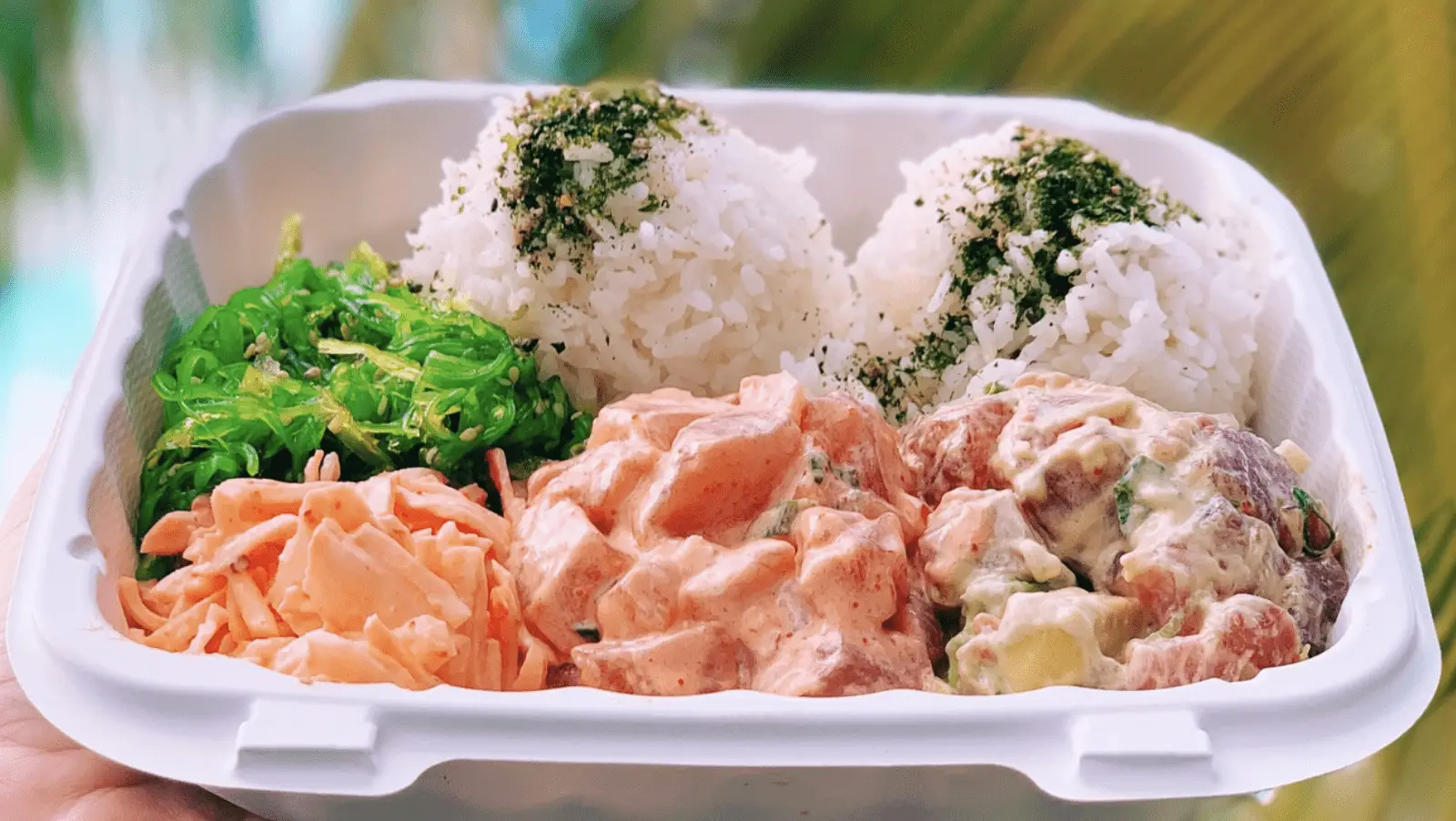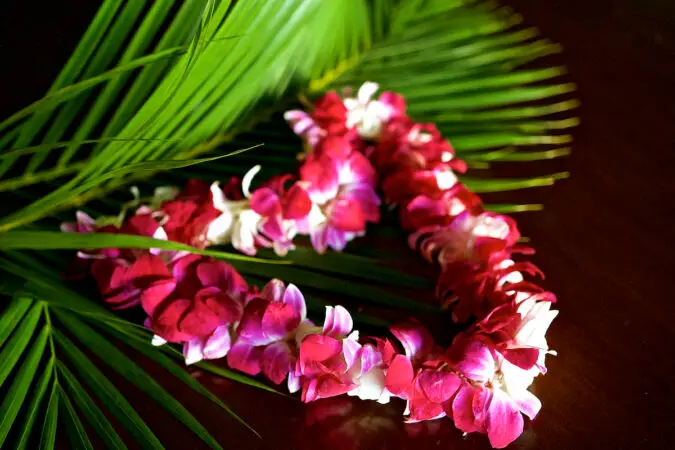Only a couple of years ago, most mainlanders visiting Hawaii provided locals a reliable laugh whenever they ordered poke. Because unless you have a passing familiarity with the Hawaiian language, you wouldn’t guess it’s pronounced poh-KAY, and you’d have been mystified about why the wahine behind the poke bar was suppressing her smile. But that was then: Poke has since become a bona fide food phenomenon on the mainland, and visitors to the Islands seeking out this Hawaiian staple have another reason to rejoice: the best poke in the world, made with the freshest fish, pretty much anywhere in Hawaii you can go.
Feature Photo: Courtesy of Tamura's Fine Wines and Liquors

Today, just about anything cut into cubes and served raw might be called poke, and there are more variations than you can count. Traditionally — i.e., starting around the time Captain Cook stumbled across the Hawaiian Islands in 1778 and probably much earlier — poke was a preparation of cubed raw reef fish mixed with sea salt, limu (seaweed) and inamona — roasted ground kukui (candlenuts). The word “poke” means “to cut crosswise” in Hawaiian, though it’s possible that the term wasn’t used to describe the dish until about the mid twentieth century. This “Hawaiian sashimi,” as poke is sometimes miscalled, was an important part of the pre-Western contact Polynesian diet. It isn’t thought to have been particularly diverse, making use as it did of the comparatively limited pantry of local ingredients.
Contact with the world beyond Hawaii and the influx of immigrants from Japan, Portugal, China, the Philippines and the United States brought new flavors — soy sauce, rice, chili, onion, avocado, sesame, mayonnaise — and poke diversified, becoming as mixed and varied as the Islands’ multicultural landscape has. Poke remains a staple because it’s simple, inexpensive, filling, balanced, portable, versatile and takes advantage of Hawaii’s access to fresh fish. As fishing techniques improved (and as nearshore reef fish populations declined with the rise of tourism), big pelagics like ‘ahi (yellowfin tuna), ono (wahoo) and billfish replaced reef fish as the central element in modern poke. Alongside those standbys you’ll often find smoked or boiled tako (octopus), scallops, mussels, crab, shrimp and, it is this writer’s grim duty to report, tofu.
If you’re a poke virgin on your way to Hawaii, start with the gateway poke: ‘ahi shoyu — yellowfin tuna with sea salt, sliced onion and scallion, typically dressed in soy sauce and sesame oil. Be sure the ‘ahi is fresh; previously frozen fish might be fine for the seasoned poke eater, just as someone introduced to beer through microbrew ale could probably stomach a Budweiser in a pinch. If the fish is fresh, it’s also more likely to have been sustainably harvested from local waters rather than caught by longline fishing vessels from Taiwan or China and imported (but you still might want to ask where the fish comes from to be sure). From there move on to the spicy ‘ahi, which is usually marinated in soy sauce, sesame oil, mayonnaise, Sriracha and dappled with crunchy orange pebbles of tobiko (flying fish roe). If you’re really hungry, try a poke bowl — the above-mentioned preparations spread over white or brown rice, like chirashi sushi.

These days poke is everywhere in Hawaii: wrapped in plastic and Styrofoam at supermarkets or built into delicate, layered towers capped with microgreens at Roy’s restaurants, which means you’ll find superior poke not only in high-end restaurants and resorts (which have a tendency to overcomplicate — and overprice — it), but at takeout stands, roadside trucks, supermarket counters and tucked in the back of liquor stores (no joke). If you want to know where the best poke is, don’t bother asking the concierge, who’ll probably circle you back into the hotel. Instead, ask the valet who brings your car around.
Oahu, being the most populous of the islands, has the best selection of local poke spots. Tamura’s Fine Wines and Liquors gets its fish fresh daily from the Honolulu Fish Auction and has five locations: Honolulu, Wahiawa, Hauula, Kapolei and Kailua. Head to the back where you’ll find the poke counter and a pretty diverse selection, including proprietary and seasonal recipes. Up on the North Shore, poke bowls derived from an old family recipe have earned Kahuku Superette a loyal following; in winter you’ll be standing in line beside locals and pro surfers alike. Back in Honolulu, Yama’s Fish Market is a mostly unknown treasure, where you can get true Hawaiian and local food to accompany its superb ‘ahi poke. Fresh Catch, with three locations, in Honolulu, Pearl City and Kaneohe, is beloved for its tako poke — smoked on-premises.

On the neighbor islands, pickings are hardly slim, but you have to know where to go: On Maui, it’s Tamura’s again, with three locations (Wailuku, Kahului and Kihei) and Like Poke?, a truck parked off Haleakala Highway in Kahului. On the Kona side of Hawaii Island, head for ‘Umeke’s Fish Market Bar & Grill in Kailua-Kona; on the Hilo side, it’s Suisan Fish Market, fins down the freshest fish in East Hawaii. For the Kauai bound, Ishihara Fish Market in Waimea is the south shore’s poke stop; on the north shore it’s The Hanalei Dolphin in Hanalei or Kilauea Fish Market in Kilauea.
If you’re in a hurry, though, you can do what locals do and hit a Foodland supermarket (or KTA on Hawaii Island), where though they often use frozen fish, they offer a wide selection. And please, kind reader, take these recommendations with the gravitas they deserve; as an Island resident, I’m hazarding my personal safety by divulging this information, a risk akin to spilling Hawaii’s best secret surfing spots to Lonely Planet. So enjoy your poke… just don’t tell ’em I sent you.










